Numerical modelling techniques for studying longwall geotechnical problems under realistic geological structures
Longwall - associated geotechnical problems have been extensively
studied by using numerical modelling methods. However, proper
representation of its geological structures remains a challenging task.
This paper presents a systematic understanding of numerical modelling
techniques for studying longwall coal mining with geological structures.
The modelling techniques derived from conventional and advanced
continuum and discontinuum methods were reviewed in detail with
emphasiz on their mechanic's formulation and applications. This study
suggests that the successful selection of a proper modelling technique
should be based on the physical principle of longwall problem, texture and
shape of materials, and mechanics formulation of the numerical program
used for modelling. The paper’s conclusions assist numerical modellers in
quickly and properly selecting modelling technique for investigating a site
- specific longwall problem.
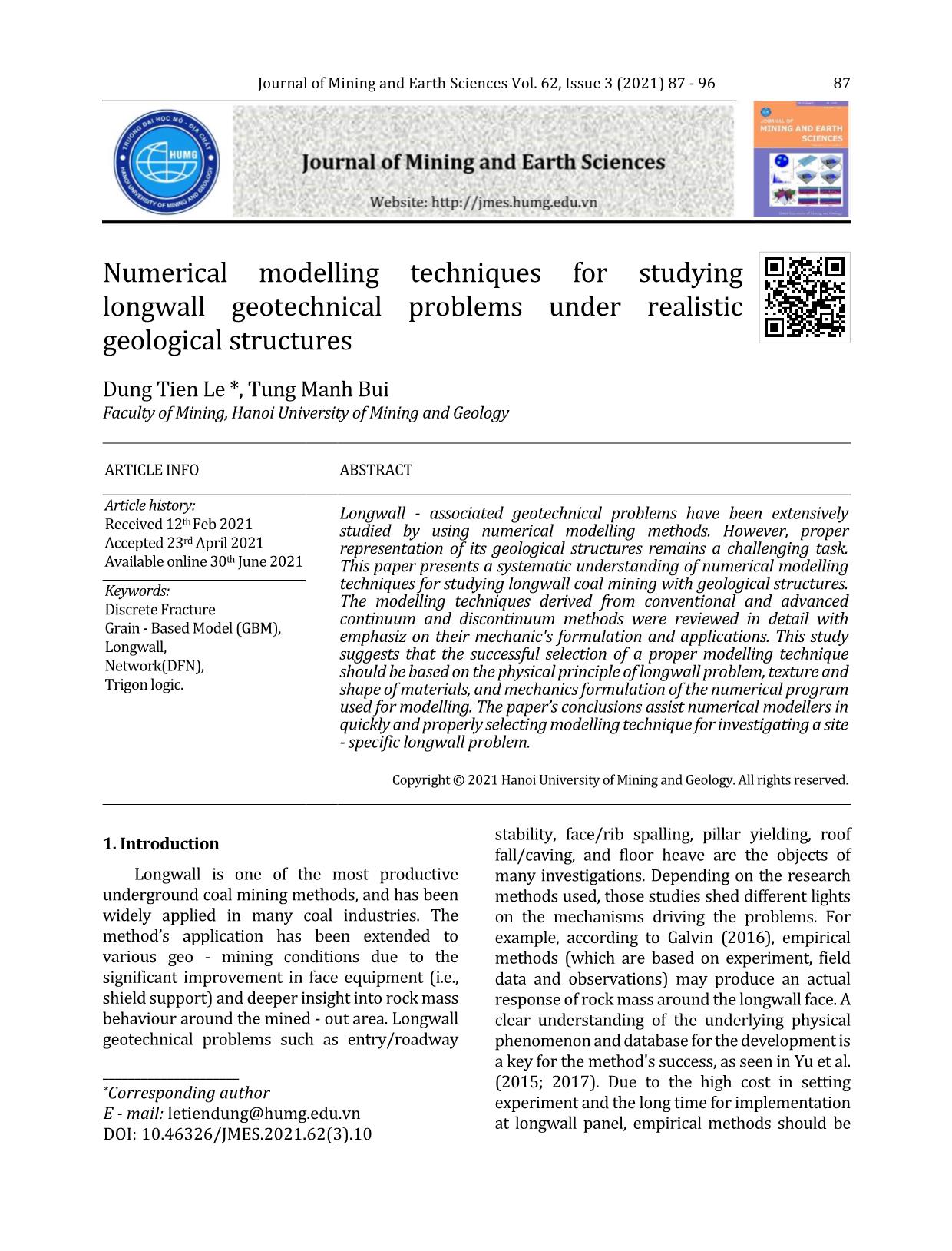
Trang 1
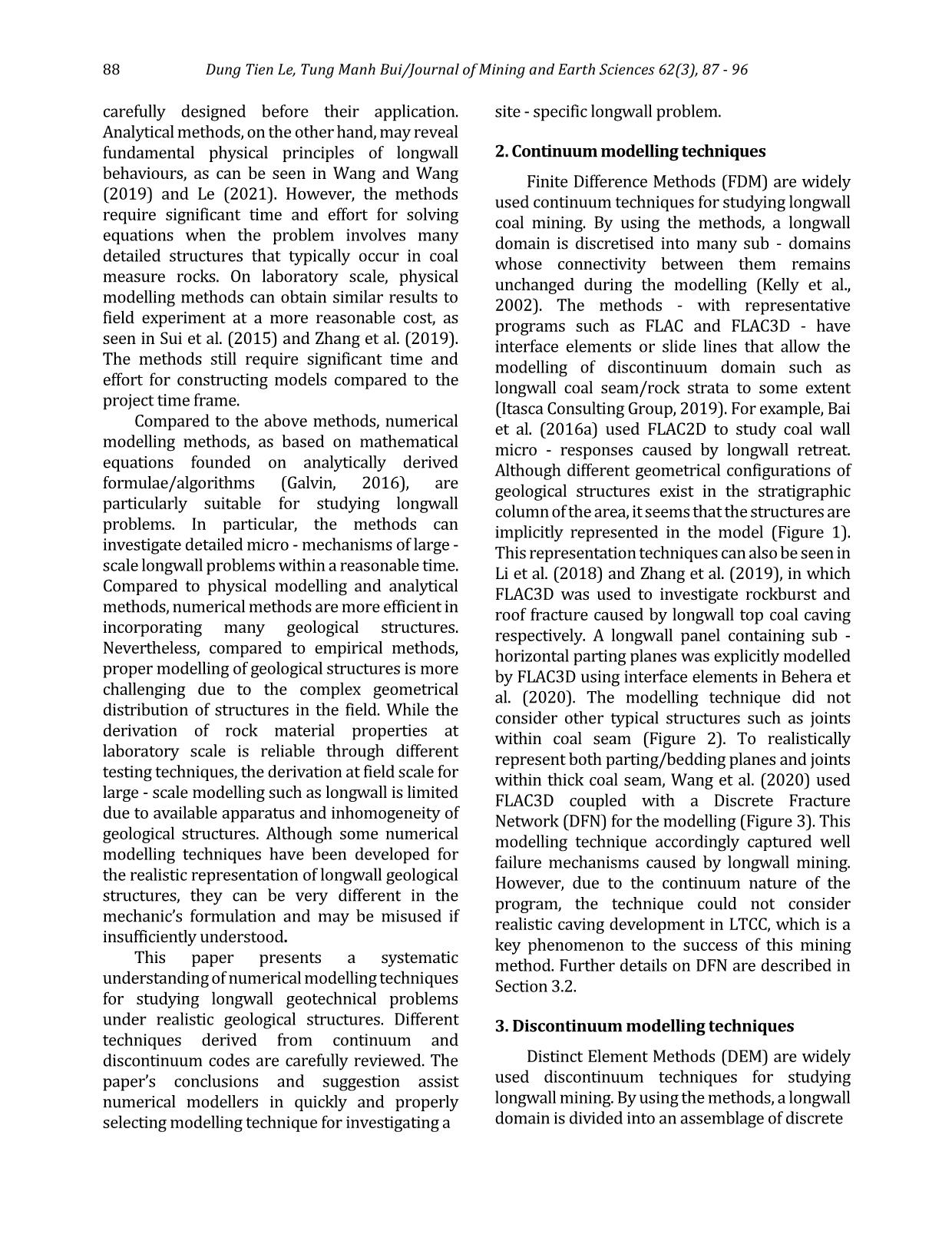
Trang 2
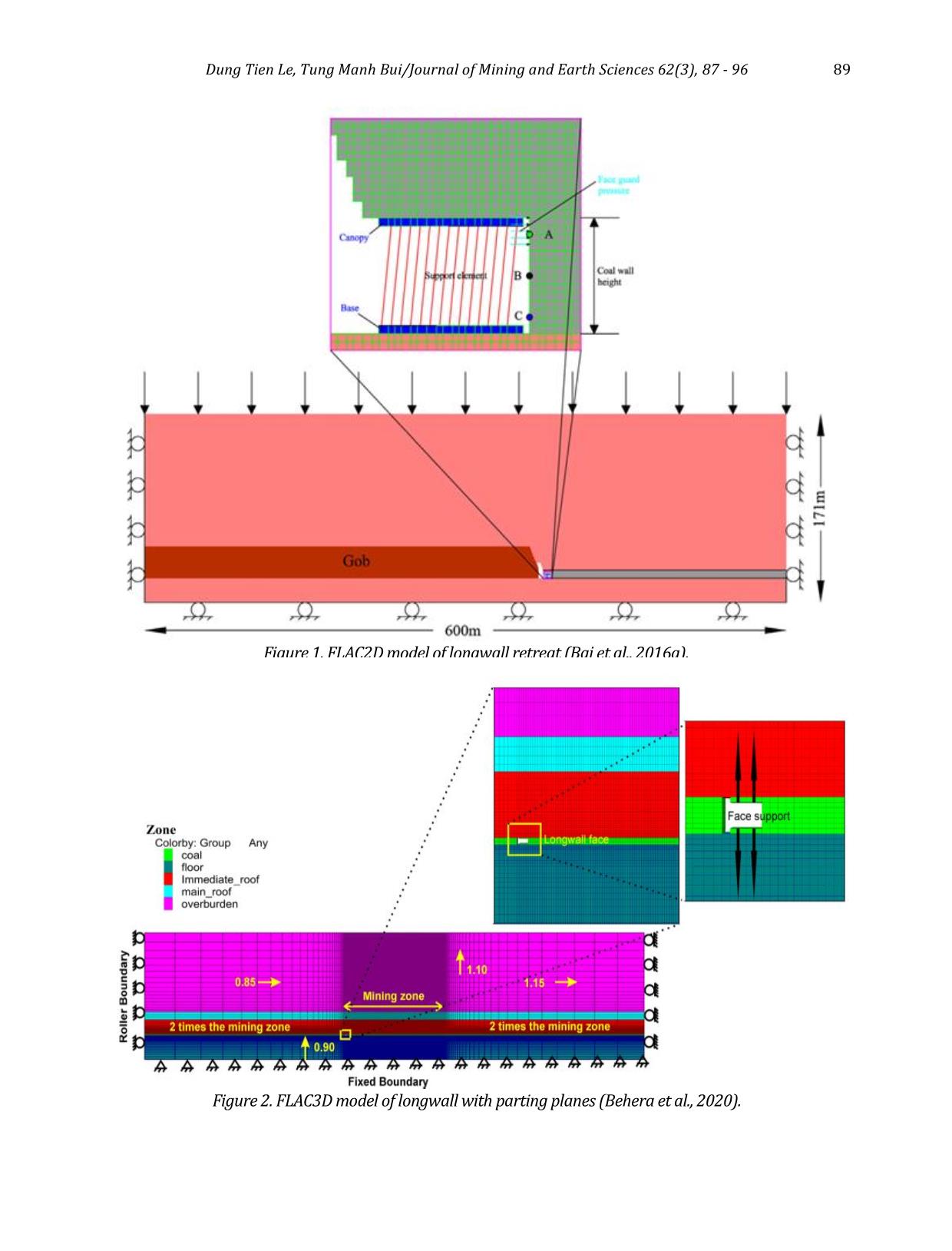
Trang 3
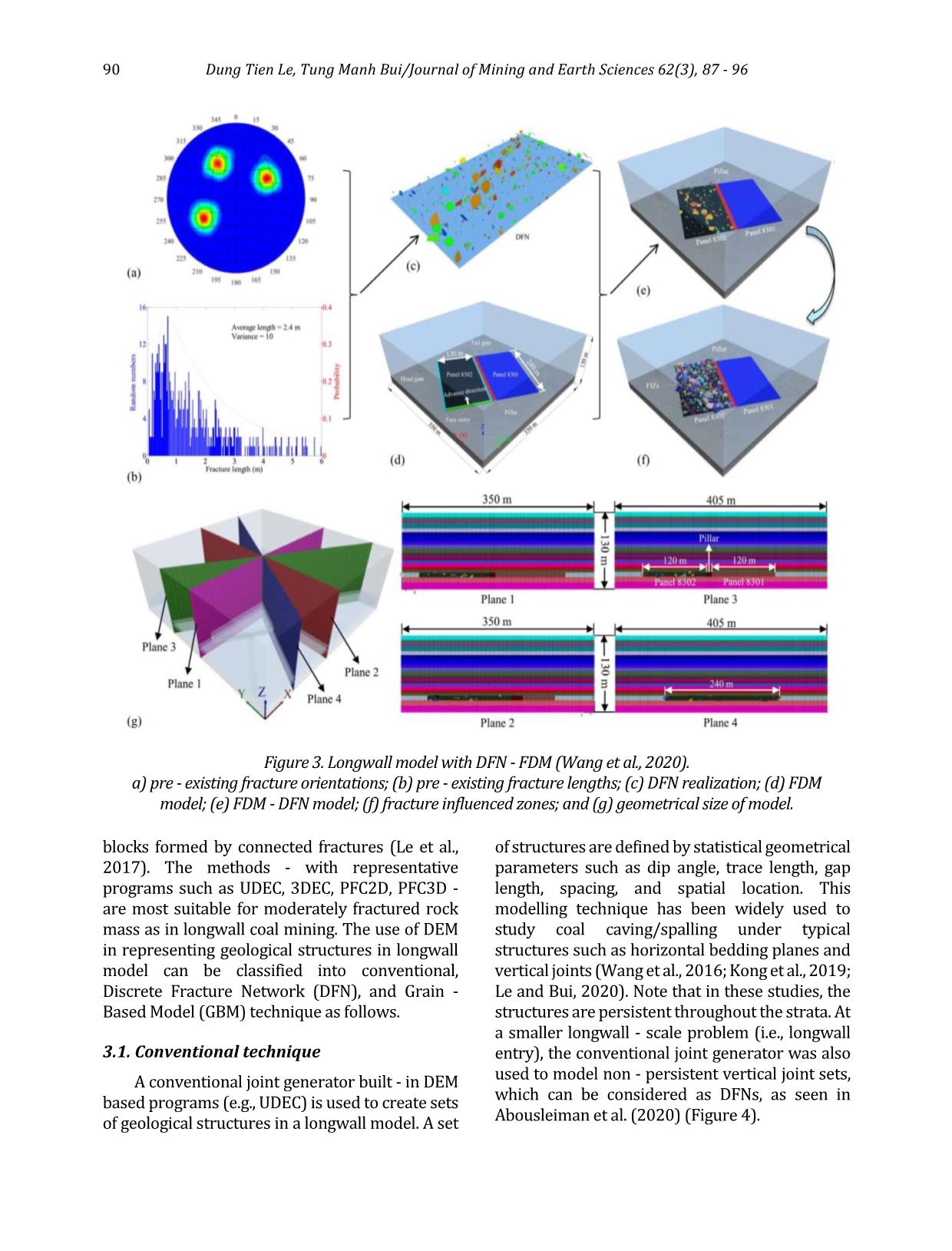
Trang 4
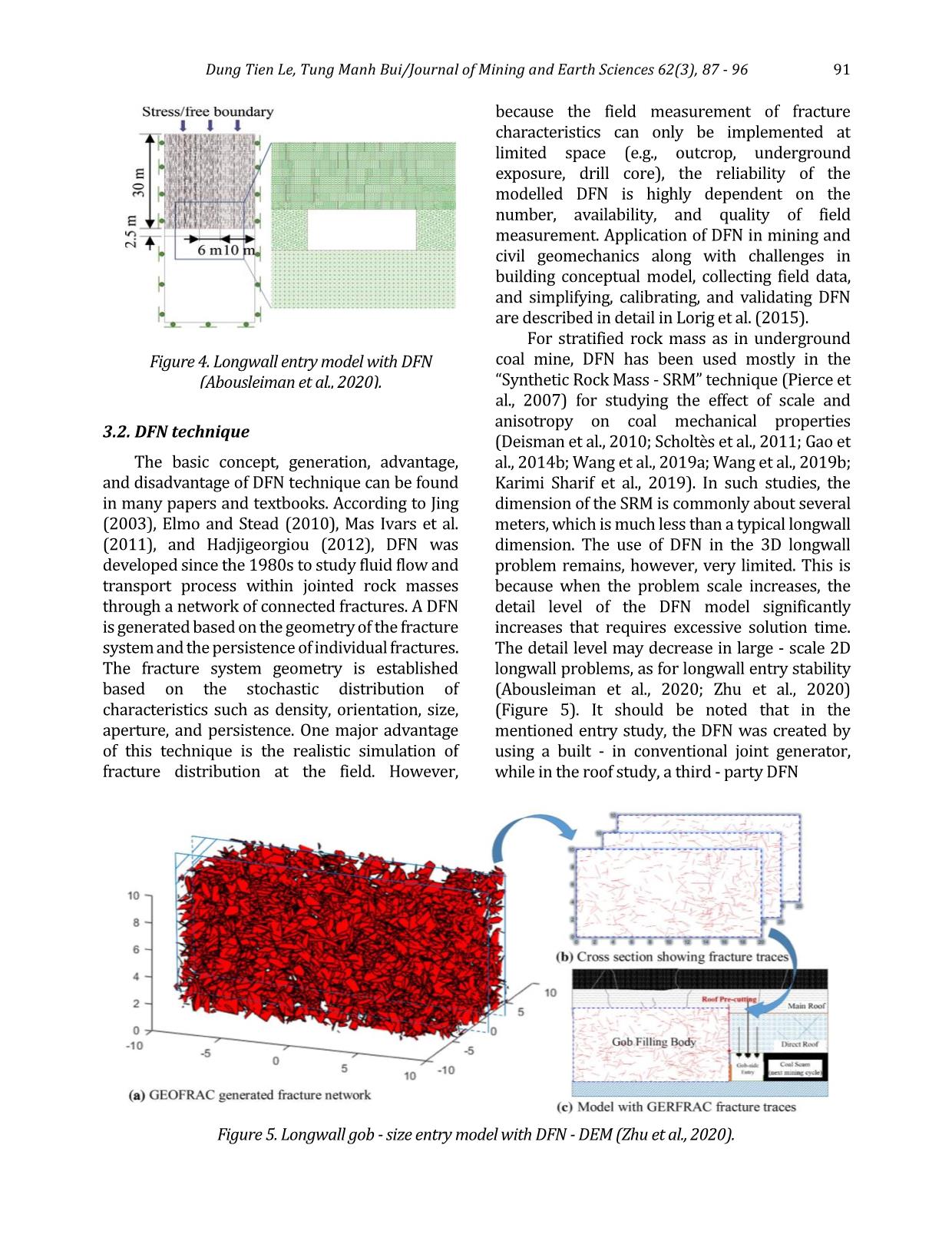
Trang 5
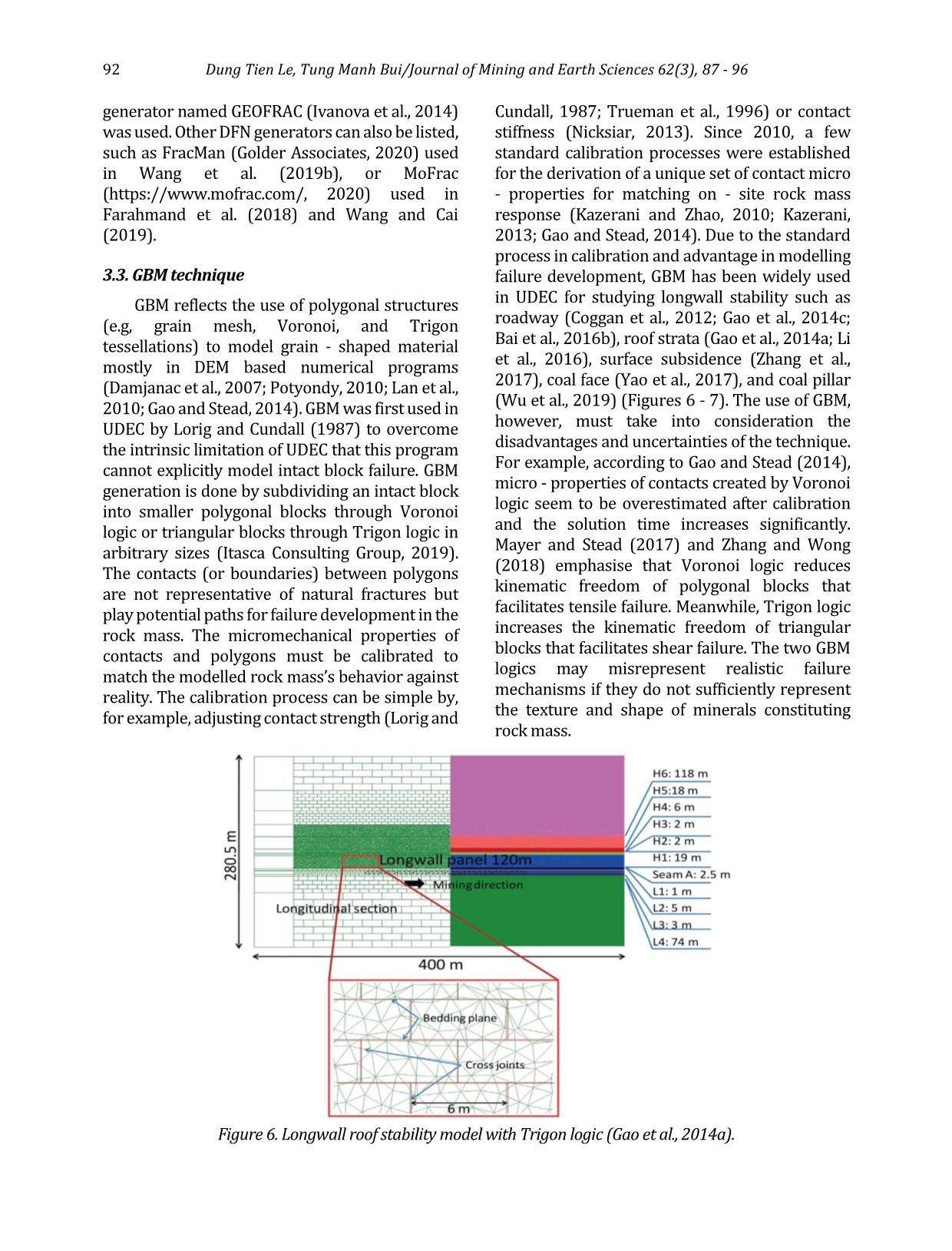
Trang 6
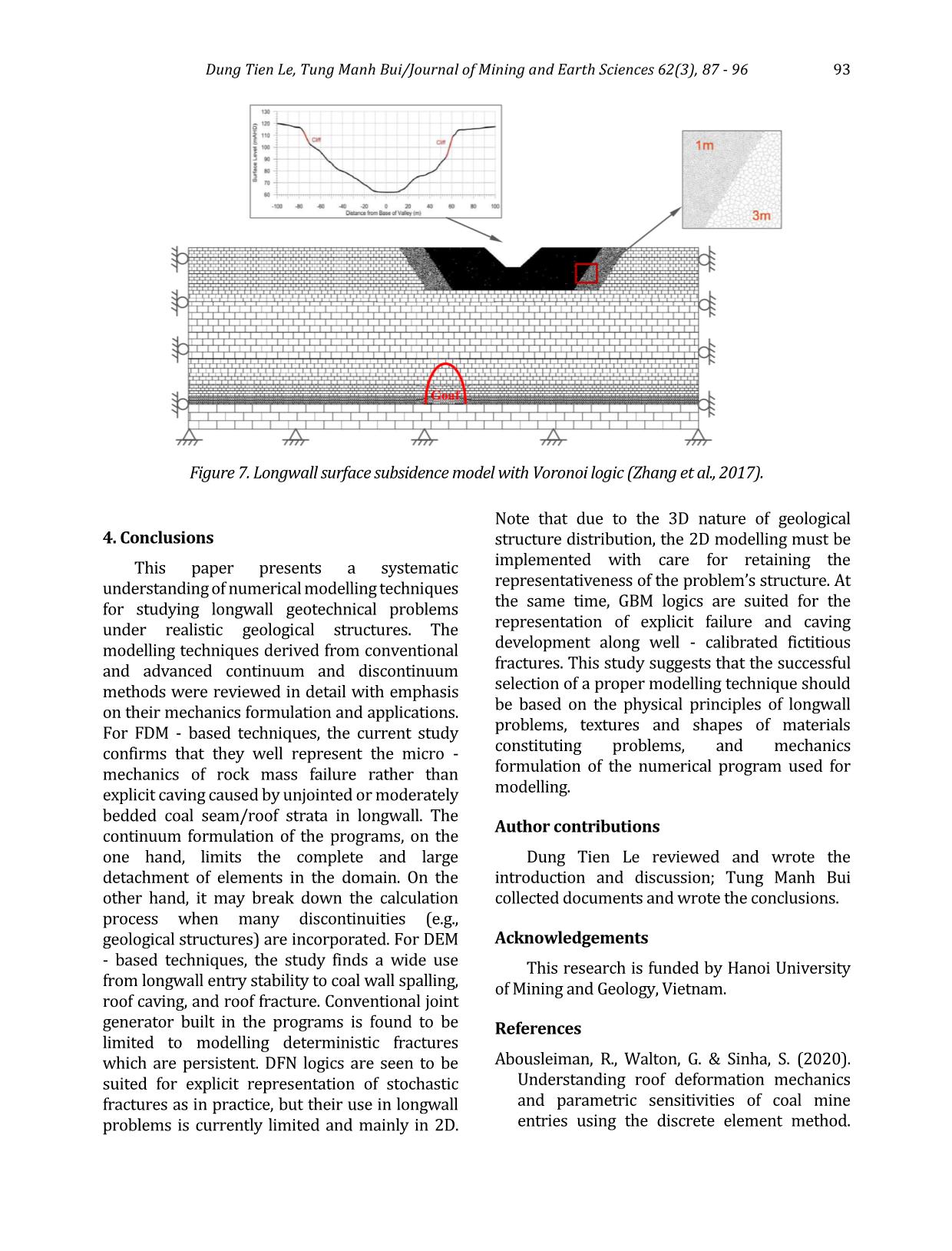
Trang 7
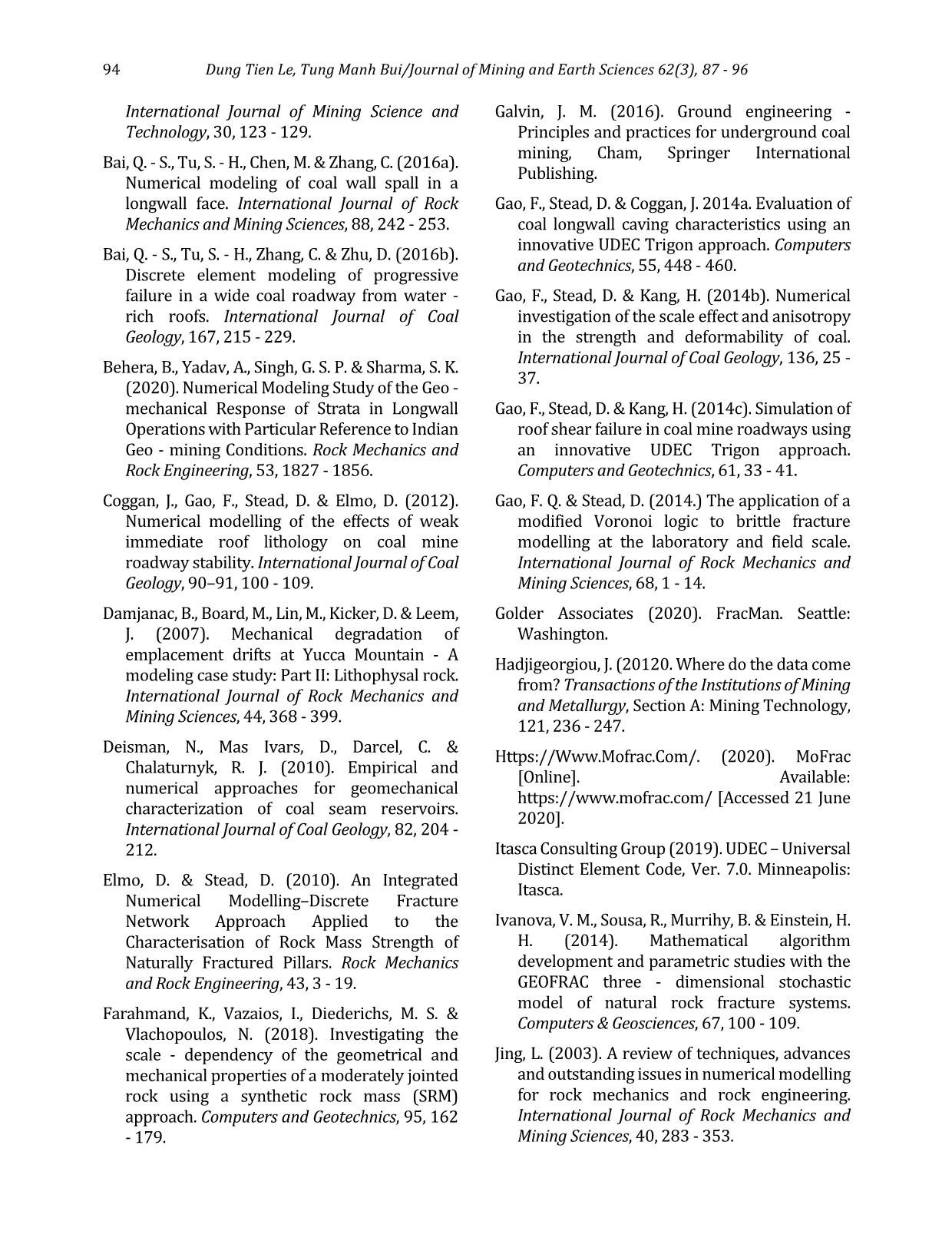
Trang 8
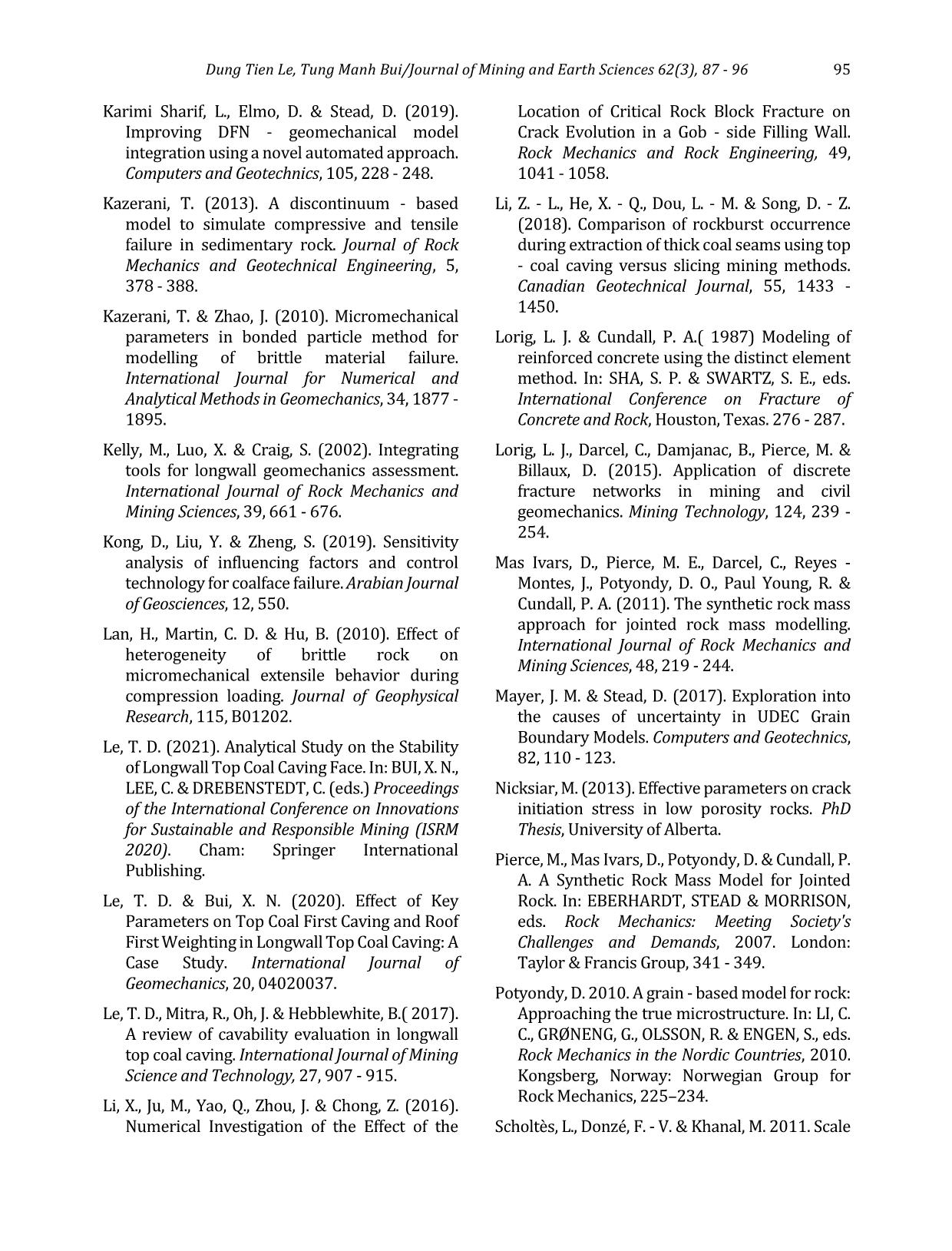
Trang 9
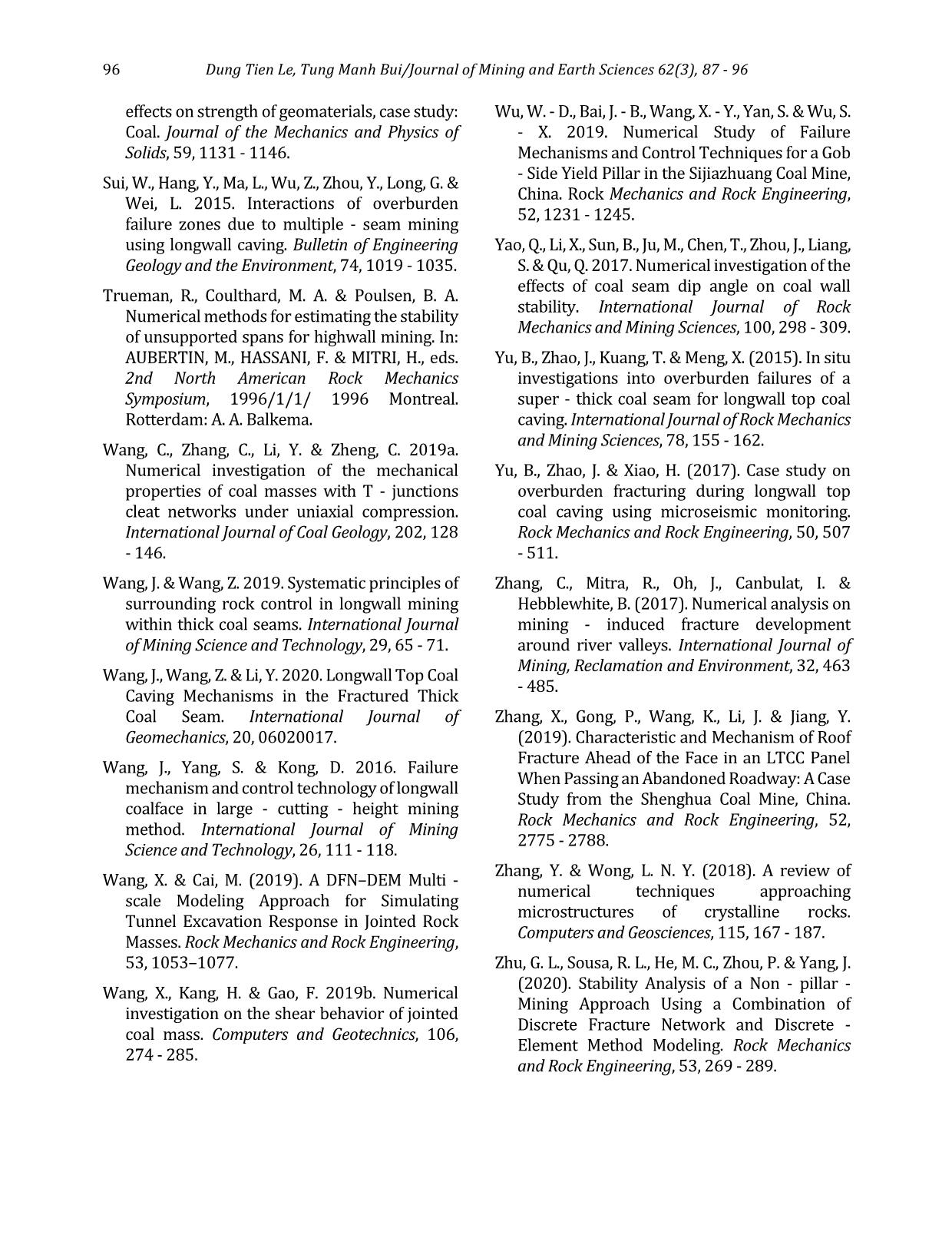
Trang 10
Tóm tắt nội dung tài liệu: Numerical modelling techniques for studying longwall geotechnical problems under realistic geological structures
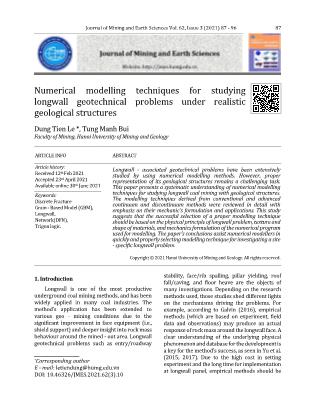
Zhang and Wong (2018) emphasise that Voronoi logic reduces kinematic freedom of polygonal blocks that facilitates tensile failure. Meanwhile, Trigon logic increases the kinematic freedom of triangular blocks that facilitates shear failure. The two GBM logics may misrepresent realistic failure mechanisms if they do not sufficiently represent the texture and shape of minerals constituting rock mass. Figure 6. Longwall roof stability model with Trigon logic (Gao et al., 2014a). Dung Tien Le, Tung Manh Bui/Journal of Mining and Earth Sciences 62(3), 87 - 96 93 4. Conclusions This paper presents a systematic understanding of numerical modelling techniques for studying longwall geotechnical problems under realistic geological structures. The modelling techniques derived from conventional and advanced continuum and discontinuum methods were reviewed in detail with emphasis on their mechanics formulation and applications. For FDM - based techniques, the current study confirms that they well represent the micro - mechanics of rock mass failure rather than explicit caving caused by unjointed or moderately bedded coal seam/roof strata in longwall. The continuum formulation of the programs, on the one hand, limits the complete and large detachment of elements in the domain. On the other hand, it may break down the calculation process when many discontinuities (e.g., geological structures) are incorporated. For DEM - based techniques, the study finds a wide use from longwall entry stability to coal wall spalling, roof caving, and roof fracture. Conventional joint generator built in the programs is found to be limited to modelling deterministic fractures which are persistent. DFN logics are seen to be suited for explicit representation of stochastic fractures as in practice, but their use in longwall problems is currently limited and mainly in 2D. Note that due to the 3D nature of geological structure distribution, the 2D modelling must be implemented with care for retaining the representativeness of the problem’s structure. At the same time, GBM logics are suited for the representation of explicit failure and caving development along well - calibrated fictitious fractures. This study suggests that the successful selection of a proper modelling technique should be based on the physical principles of longwall problems, textures and shapes of materials constituting problems, and mechanics formulation of the numerical program used for modelling. Author contributions Dung Tien Le reviewed and wrote the introduction and discussion; Tung Manh Bui collected documents and wrote the conclusions. Acknowledgements This research is funded by Hanoi University of Mining and Geology, Vietnam. References Abousleiman, R., Walton, G. & Sinha, S. (2020). Understanding roof deformation mechanics and parametric sensitivities of coal mine entries using the discrete element method. Figure 7. Longwall surface subsidence model with Voronoi logic (Zhang et al., 2017). 94 Dung Tien Le, Tung Manh Bui/Journal of Mining and Earth Sciences 62(3), 87 - 96 International Journal of Mining Science and Technology, 30, 123 - 129. Bai, Q. - S., Tu, S. - H., Chen, M. & Zhang, C. (2016a). Numerical modeling of coal wall spall in a longwall face. International Journal of Rock Mechanics and Mining Sciences, 88, 242 - 253. Bai, Q. - S., Tu, S. - H., Zhang, C. & Zhu, D. (2016b). Discrete element modeling of progressive failure in a wide coal roadway from water - rich roofs. International Journal of Coal Geology, 167, 215 - 229. Behera, B., Yadav, A., Singh, G. S. P. & Sharma, S. K. (2020). Numerical Modeling Study of the Geo - mechanical Response of Strata in Longwall Operations with Particular Reference to Indian Geo - mining Conditions. Rock Mechanics and Rock Engineering, 53, 1827 - 1856. Coggan, J., Gao, F., Stead, D. & Elmo, D. (2012). Numerical modelling of the effects of weak immediate roof lithology on coal mine roadway stability. International Journal of Coal Geology, 90–91, 100 - 109. Damjanac, B., Board, M., Lin, M., Kicker, D. & Leem, J. (2007). Mechanical degradation of emplacement drifts at Yucca Mountain - A modeling case study: Part II: Lithophysal rock. International Journal of Rock Mechanics and Mining Sciences, 44, 368 - 399. Deisman, N., Mas Ivars, D., Darcel, C. & Chalaturnyk, R. J. (2010). Empirical and numerical approaches for geomechanical characterization of coal seam reservoirs. International Journal of Coal Geology, 82, 204 - 212. Elmo, D. & Stead, D. (2010). An Integrated Numerical Modelling–Discrete Fracture Network Approach Applied to the Characterisation of Rock Mass Strength of Naturally Fractured Pillars. Rock Mechanics and Rock Engineering, 43, 3 - 19. Farahmand, K., Vazaios, I., Diederichs, M. S. & Vlachopoulos, N. (2018). Investigating the scale - dependency of the geometrical and mechanical properties of a moderately jointed rock using a synthetic rock mass (SRM) approach. Computers and Geotechnics, 95, 162 - 179. Galvin, J. M. (2016). Ground engineering - Principles and practices for underground coal mining, Cham, Springer International Publishing. Gao, F., Stead, D. & Coggan, J. 2014a. Evaluation of coal longwall caving characteristics using an innovative UDEC Trigon approach. Computers and Geotechnics, 55, 448 - 460. Gao, F., Stead, D. & Kang, H. (2014b). Numerical investigation of the scale effect and anisotropy in the strength and deformability of coal. International Journal of Coal Geology, 136, 25 - 37. Gao, F., Stead, D. & Kang, H. (2014c). Simulation of roof shear failure in coal mine roadways using an innovative UDEC Trigon approach. Computers and Geotechnics, 61, 33 - 41. Gao, F. Q. & Stead, D. (2014.) The application of a modified Voronoi logic to brittle fracture modelling at the laboratory and field scale. International Journal of Rock Mechanics and Mining Sciences, 68, 1 - 14. Golder Associates (2020). FracMan. Seattle: Washington. Hadjigeorgiou, J. (20120. Where do the data come from? Transactions of the Institutions of Mining and Metallurgy, Section A: Mining Technology, 121, 236 - 247. Https://Www.Mofrac.Com/. (2020). MoFrac [Online]. Available: https://www.mofrac.com/ [Accessed 21 June 2020]. Itasca Consulting Group (2019). UDEC – Universal Distinct Element Code, Ver. 7.0. Minneapolis: Itasca. Ivanova, V. M., Sousa, R., Murrihy, B. & Einstein, H. H. (2014). Mathematical algorithm development and parametric studies with the GEOFRAC three - dimensional stochastic model of natural rock fracture systems. Computers & Geosciences, 67, 100 - 109. Jing, L. (2003). A review of techniques, advances and outstanding issues in numerical modelling for rock mechanics and rock engineering. International Journal of Rock Mechanics and Mining Sciences, 40, 283 - 353. Dung Tien Le, Tung Manh Bui/Journal of Mining and Earth Sciences 62(3), 87 - 96 95 Karimi Sharif, L., Elmo, D. & Stead, D. (2019). Improving DFN - geomechanical model integration using a novel automated approach. Computers and Geotechnics, 105, 228 - 248. Kazerani, T. (2013). A discontinuum - based model to simulate compressive and tensile failure in sedimentary rock. Journal of Rock Mechanics and Geotechnical Engineering, 5, 378 - 388. Kazerani, T. & Zhao, J. (2010). Micromechanical parameters in bonded particle method for modelling of brittle material failure. International Journal for Numerical and Analytical Methods in Geomechanics, 34, 1877 - 1895. Kelly, M., Luo, X. & Craig, S. (2002). Integrating tools for longwall geomechanics assessment. International Journal of Rock Mechanics and Mining Sciences, 39, 661 - 676. Kong, D., Liu, Y. & Zheng, S. (2019). Sensitivity analysis of influencing factors and control technology for coalface failure. Arabian Journal of Geosciences, 12, 550. Lan, H., Martin, C. D. & Hu, B. (2010). Effect of heterogeneity of brittle rock on micromechanical extensile behavior during compression loading. Journal of Geophysical Research, 115, B01202. Le, T. D. (2021). Analytical Study on the Stability of Longwall Top Coal Caving Face. In: BUI, X. N., LEE, C. & DREBENSTEDT, C. (eds.) Proceedings of the International Conference on Innovations for Sustainable and Responsible Mining (ISRM 2020). Cham: Springer International Publishing. Le, T. D. & Bui, X. N. (2020). Effect of Key Parameters on Top Coal First Caving and Roof First Weighting in Longwall Top Coal Caving: A Case Study. International Journal of Geomechanics, 20, 04020037. Le, T. D., Mitra, R., Oh, J. & Hebblewhite, B.( 2017). A review of cavability evaluation in longwall top coal caving. International Journal of Mining Science and Technology, 27, 907 - 915. Li, X., Ju, M., Yao, Q., Zhou, J. & Chong, Z. (2016). Numerical Investigation of the Effect of the Location of Critical Rock Block Fracture on Crack Evolution in a Gob - side Filling Wall. Rock Mechanics and Rock Engineering, 49, 1041 - 1058. Li, Z. - L., He, X. - Q., Dou, L. - M. & Song, D. - Z. (2018). Comparison of rockburst occurrence during extraction of thick coal seams using top - coal caving versus slicing mining methods. Canadian Geotechnical Journal, 55, 1433 - 1450. Lorig, L. J. & Cundall, P. A.( 1987) Modeling of reinforced concrete using the distinct element method. In: SHA, S. P. & SWARTZ, S. E., eds. International Conference on Fracture of Concrete and Rock, Houston, Texas. 276 - 287. Lorig, L. J., Darcel, C., Damjanac, B., Pierce, M. & Billaux, D. (2015). Application of discrete fracture networks in mining and civil geomechanics. Mining Technology, 124, 239 - 254. Mas Ivars, D., Pierce, M. E., Darcel, C., Reyes - Montes, J., Potyondy, D. O., Paul Young, R. & Cundall, P. A. (2011). The synthetic rock mass approach for jointed rock mass modelling. International Journal of Rock Mechanics and Mining Sciences, 48, 219 - 244. Mayer, J. M. & Stead, D. (2017). Exploration into the causes of uncertainty in UDEC Grain Boundary Models. Computers and Geotechnics, 82, 110 - 123. Nicksiar, M. (2013). Effective parameters on crack initiation stress in low porosity rocks. PhD Thesis, University of Alberta. Pierce, M., Mas Ivars, D., Potyondy, D. & Cundall, P. A. A Synthetic Rock Mass Model for Jointed Rock. In: EBERHARDT, STEAD & MORRISON, eds. Rock Mechanics: Meeting Society's Challenges and Demands, 2007. London: Taylor & Francis Group, 341 - 349. Potyondy, D. 2010. A grain - based model for rock: Approaching the true microstructure. In: LI, C. C., GRØNENG, G., OLSSON, R. & ENGEN, S., eds. Rock Mechanics in the Nordic Countries, 2010. Kongsberg, Norway: Norwegian Group for Rock Mechanics, 225–234. Scholtès, L., Donzé, F. - V. & Khanal, M. 2011. Scale 96 Dung Tien Le, Tung Manh Bui/Journal of Mining and Earth Sciences 62(3), 87 - 96 effects on strength of geomaterials, case study: Coal. Journal of the Mechanics and Physics of Solids, 59, 1131 - 1146. Sui, W., Hang, Y., Ma, L., Wu, Z., Zhou, Y., Long, G. & Wei, L. 2015. Interactions of overburden failure zones due to multiple - seam mining using longwall caving. Bulletin of Engineering Geology and the Environment, 74, 1019 - 1035. Trueman, R., Coulthard, M. A. & Poulsen, B. A. Numerical methods for estimating the stability of unsupported spans for highwall mining. In: AUBERTIN, M., HASSANI, F. & MITRI, H., eds. 2nd North American Rock Mechanics Symposium, 1996/1/1/ 1996 Montreal. Rotterdam: A. A. Balkema. Wang, C., Zhang, C., Li, Y. & Zheng, C. 2019a. Numerical investigation of the mechanical properties of coal masses with T - junctions cleat networks under uniaxial compression. International Journal of Coal Geology, 202, 128 - 146. Wang, J. & Wang, Z. 2019. Systematic principles of surrounding rock control in longwall mining within thick coal seams. International Journal of Mining Science and Technology, 29, 65 - 71. Wang, J., Wang, Z. & Li, Y. 2020. Longwall Top Coal Caving Mechanisms in the Fractured Thick Coal Seam. International Journal of Geomechanics, 20, 06020017. Wang, J., Yang, S. & Kong, D. 2016. Failure mechanism and control technology of longwall coalface in large - cutting - height mining method. International Journal of Mining Science and Technology, 26, 111 - 118. Wang, X. & Cai, M. (2019). A DFN–DEM Multi - scale Modeling Approach for Simulating Tunnel Excavation Response in Jointed Rock Masses. Rock Mechanics and Rock Engineering, 53, 1053–1077. Wang, X., Kang, H. & Gao, F. 2019b. Numerical investigation on the shear behavior of jointed coal mass. Computers and Geotechnics, 106, 274 - 285. Wu, W. - D., Bai, J. - B., Wang, X. - Y., Yan, S. & Wu, S. - X. 2019. Numerical Study of Failure Mechanisms and Control Techniques for a Gob - Side Yield Pillar in the Sijiazhuang Coal Mine, China. Rock Mechanics and Rock Engineering, 52, 1231 - 1245. Yao, Q., Li, X., Sun, B., Ju, M., Chen, T., Zhou, J., Liang, S. & Qu, Q. 2017. Numerical investigation of the effects of coal seam dip angle on coal wall stability. International Journal of Rock Mechanics and Mining Sciences, 100, 298 - 309. Yu, B., Zhao, J., Kuang, T. & Meng, X. (2015). In situ investigations into overburden failures of a super - thick coal seam for longwall top coal caving. International Journal of Rock Mechanics and Mining Sciences, 78, 155 - 162. Yu, B., Zhao, J. & Xiao, H. (2017). Case study on overburden fracturing during longwall top coal caving using microseismic monitoring. Rock Mechanics and Rock Engineering, 50, 507 - 511. Zhang, C., Mitra, R., Oh, J., Canbulat, I. & Hebblewhite, B. (2017). Numerical analysis on mining - induced fracture development around river valleys. International Journal of Mining, Reclamation and Environment, 32, 463 - 485. Zhang, X., Gong, P., Wang, K., Li, J. & Jiang, Y. (2019). Characteristic and Mechanism of Roof Fracture Ahead of the Face in an LTCC Panel When Passing an Abandoned Roadway: A Case Study from the Shenghua Coal Mine, China. Rock Mechanics and Rock Engineering, 52, 2775 - 2788. Zhang, Y. & Wong, L. N. Y. (2018). A review of numerical techniques approaching microstructures of crystalline rocks. Computers and Geosciences, 115, 167 - 187. Zhu, G. L., Sousa, R. L., He, M. C., Zhou, P. & Yang, J. (2020). Stability Analysis of a Non - pillar - Mining Approach Using a Combination of Discrete Fracture Network and Discrete - Element Method Modeling. Rock Mechanics and Rock Engineering, 53, 269 - 289.
File đính kèm:
 numerical_modelling_techniques_for_studying_longwall_geotech.pdf
numerical_modelling_techniques_for_studying_longwall_geotech.pdf

